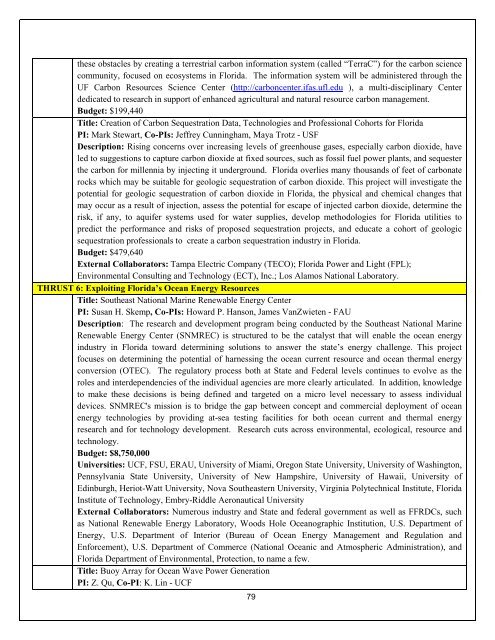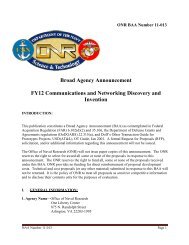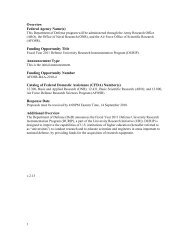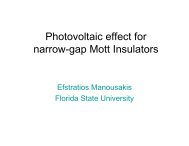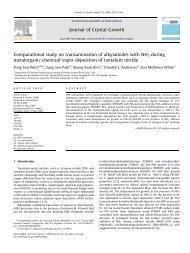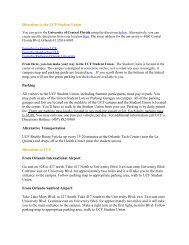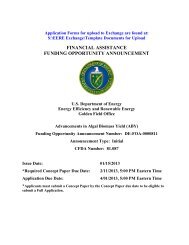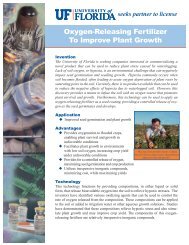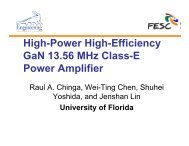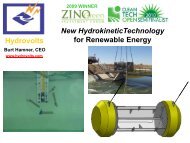Annual Report- Part III - Florida Energy Systems Consortium
Annual Report- Part III - Florida Energy Systems Consortium
Annual Report- Part III - Florida Energy Systems Consortium
Create successful ePaper yourself
Turn your PDF publications into a flip-book with our unique Google optimized e-Paper software.
these obstacles by creating a terrestrial carbon information system (called “TerraC”) for the carbon sciencecommunity, focused on ecosystems in <strong>Florida</strong>. The information system will be administered through theUF Carbon Resources Science Center (http://carboncenter.ifas.ufl.edu ), a multi-disciplinary Centerdedicated to research in support of enhanced agricultural and natural resource carbon management.Budget: $199,440Title: Creation of Carbon Sequestration Data, Technologies and Professional Cohorts for <strong>Florida</strong>PI: Mark Stewart, Co-PIs: Jeffrey Cunningham, Maya Trotz - USFDescription: Rising concerns over increasing levels of greenhouse gases, especially carbon dioxide, haveled to suggestions to capture carbon dioxide at fixed sources, such as fossil fuel power plants, and sequesterthe carbon for millennia by injecting it underground. <strong>Florida</strong> overlies many thousands of feet of carbonaterocks which may be suitable for geologic sequestration of carbon dioxide. This project will investigate thepotential for geologic sequestration of carbon dioxide in <strong>Florida</strong>, the physical and chemical changes thatmay occur as a result of injection, assess the potential for escape of injected carbon dioxide, determine therisk, if any, to aquifer systems used for water supplies, develop methodologies for <strong>Florida</strong> utilities topredict the performance and risks of proposed sequestration projects, and educate a cohort of geologicsequestration professionals to create a carbon sequestration industry in <strong>Florida</strong>.Budget: $479,640External Collaborators: Tampa Electric Company (TECO); <strong>Florida</strong> Power and Light (FPL);Environmental Consulting and Technology (ECT), Inc.; Los Alamos National Laboratory.THRUST 6: Exploiting <strong>Florida</strong>’s Ocean <strong>Energy</strong> ResourcesTitle: Southeast National Marine Renewable <strong>Energy</strong> CenterPI: Susan H. Skemp, Co-PIs: Howard P. Hanson, James VanZwieten - FAUDescription: The research and development program being conducted by the Southeast National MarineRenewable <strong>Energy</strong> Center (SNMREC) is structured to be the catalyst that will enable the ocean energyindustry in <strong>Florida</strong> toward determining solutions to answer the state’s energy challenge. This projectfocuses on determining the potential of harnessing the ocean current resource and ocean thermal energyconversion (OTEC). The regulatory process both at State and Federal levels continues to evolve as theroles and interdependencies of the individual agencies are more clearly articulated. In addition, knowledgeto make these decisions is being defined and targeted on a micro level necessary to assess individualdevices. SNMREC's mission is to bridge the gap between concept and commercial deployment of oceanenergy technologies by providing at-sea testing facilities for both ocean current and thermal energyresearch and for technology development. Research cuts across environmental, ecological, resource andtechnology.Budget: $8,750,000Universities: UCF, FSU, ERAU, University of Miami, Oregon State University, University of Washington,Pennsylvania State University, University of New Hampshire, University of Hawaii, University ofEdinburgh, Heriot-Watt University, Nova Southeastern University, Virginia Polytechnical Institute, <strong>Florida</strong>Institute of Technology, Embry-Riddle Aeronautical UniversityExternal Collaborators: Numerous industry and State and federal government as well as FFRDCs, suchas National Renewable <strong>Energy</strong> Laboratory, Woods Hole Oceanographic Institution, U.S. Department of<strong>Energy</strong>, U.S. Department of Interior (Bureau of Ocean <strong>Energy</strong> Management and Regulation andEnforcement), U.S. Department of Commerce (National Oceanic and Atmospheric Administration), and<strong>Florida</strong> Department of Environmental, Protection, to name a few.Title: Buoy Array for Ocean Wave Power GenerationPI: Z. Qu, Co-PI: K. Lin - UCF79


